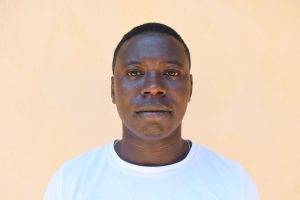The 500 people in the Kiliku Community only have one source of water. The source has several problems, with one of the major problems being its distance. The road people must travel to collect water is long and arduous, stealing their time and making life very hard for everyone.

The journey for water.
"The road to the earth dam is marked by huge stones, especially as you approach the source. On the way, the community members have to walk through cracked terrain that is dangerous, and one can barely walk through at night," shared Field Officer Jefferson Mutie.
Sixteen-year-old Simon faces that difficult journey daily. He goes to school, riding his bike both ways, and then is sent to collect water. However, since the road to the water point is uphill and rocky, he can't ride his bike. He must walk.
"I ride my bicycle to and from school, which barely takes 45 minutes. Then, coming home, I am tasked with fetching water. Already, my weary legs have to trek for other kilometers to get water. This makes me feel bad," shared Simon.

By the time he returns, his day is consumed, meaning he can only make one trip to collect water. This means his household won't have sufficient water, and they will have to make sacrifices.
"I am a school-going boy, and most of the time, I fetch water after reporting back from school. I have to trek late in the evening, thus making it impossible for me to get water on many trips regardless of the water needs at our home," Simon shared.
"Sometimes, when we don't have enough water at the household, I tend to leave my uniform uncleaned for a couple of days, if not a week; this makes me walk around the school very uncomfortable," he continued.
Even though he has little spare time, Simon still has big dreams! If he had accessible water, he would have the tools to reach those goals.

"I would use that time to play football as I am a football enthusiast, although [our] water needs limit me. My dream is to be an engineer and play international football," Simon shared.
"The sand dam (paired with a dug well) will serve many members with clean, sufficient, and safe water for drinking, cooking, washing, and for their livestock. It will also address the community's water scarcity by providing a reliable and sustainable source of water. This will improve access to clean water for drinking, irrigation, and sanitation, significantly enhancing the quality of life. The sand dam will foster a healthier, more resilient community. Consequently, it will enhance the health and well-being of their children at school and patients at their healthcare facility. With fewer waterborne diseases and less time spent collecting water, school-going children can focus on education and health, ultimately fostering a more prosperous future for everyone," concluded Jefferson.
Solving the water crisis in this community will require a multifaceted system that will work together to create a sustainable water source that will serve this community for years to come.
Steps Toward a Solution
Our technical experts worked with the local community to identify the most effective solution to their water crisis. Together, they decided to construct a sand dam and dug well.
Sand Dam
Sand dams are sought-after, climate-smart, and lasting water solutions, providing hope and resilience to communities in arid Southeastern Kenya. Think of them like giant sandboxes constructed in seasonal rivers that would typically quickly dry up after the rainy season. Instead of holding water like traditional dams, they collect sand and silt.
When infrequent rains do come, these dams catch a percentage of the river's flow, letting most of the water continue downstream to other communities. But here's the magic: the sand they collect acts like a natural filter, holding onto water long after the river's gone dry. Then, wells are constructed nearby, creating a reliable water source even during the driest times.
And the benefits don't stop there! In communities impacted by climate change, sand dams replenish groundwater and prevent soil erosion. Even during severe droughts, the consistent water supply from these sand dams allows farmers to thrive, giving way for enough food not only for their families but also to sell in local markets.
The most remarkable aspect of sand dams is how they involve the local community every step of the way, giving them a sense of ownership and pride in solving their own water shortage and managing their own water resources.
This sand dam will be connected to a dug well to make the water more accessible.
Community Education & Ownership
Hygiene and sanitation training are integral to our water projects. Training is tailored to each community's specific needs and includes key topics such as proper water handling, improved hygiene practices, disease transmission prevention, and care of the new water point. Safe water and improved hygiene habits foster a healthier future for everyone in the community. Encouraged and supported by the guidance of our team, a water user committee representative of the community's diverse members assumes responsibility for maintaining the water point, often gathering fees to ensure its upkeep.

 Sand Dam
Sand Dam
 Rehabilitation Project
Rehabilitation Project



















